
"Labyrinthodontia" is an informal grouping of extinct predatory amphibians which were major components of ecosystems in the late Paleozoic and early Mesozoic eras. Traditionally considered a subclass of the class Amphibia, modern classification systems recognize that labyrinthodonts are not a formal natural group (clade) exclusive of other tetrapods. Instead, they consistute an evolutionary grade, ancestral to living tetrapods such as lissamphibians and amniotes. "Labyrinthodont"-grade vertebrates evolved from lobe-finned fishes in the Devonian, though a formal boundary between fish and amphibian is difficult to define at this point in time.

Temnospondyli or temnospondyls is a diverse ancient order of small to giant tetrapods—often considered primitive amphibians—that flourished worldwide during the Carboniferous, Permian and Triassic periods, with fossils being found on every continent. A few species continued into the Jurassic and Early Cretaceous periods, but all had gone extinct by the Late Cretaceous. During about 210 million years of evolutionary history, they adapted to a wide range of habitats, including freshwater, terrestrial, and even coastal marine environments. Their life history is well understood, with fossils known from the larval stage, metamorphosis and maturity. Most temnospondyls were semiaquatic, although some were almost fully terrestrial, returning to the water only to breed. These temnospondyls were some of the first vertebrates fully adapted to life on land. Although temnospondyls are amphibians, many had characteristics such as scales and armour-like bony plates that distinguish them from the modern soft-bodied lissamphibians.
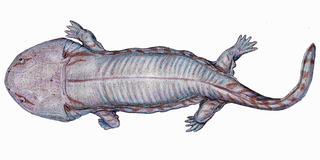
The Stereospondyli are a group of extinct temnospondyl amphibians that existed primarily during the Mesozoic period. They are known from all seven continents and were common components of many Triassic ecosystems, likely filling a similar ecological niche to modern crocodilians prior to the diversification of pseudosuchian archosaurs.
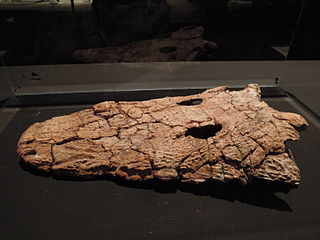
Eryosuchus is an extinct genus of capitosauroid temnospondyl from the Middle Triassic of northern Russia. It was a very large predator: the largest specimen known could reach up to 3.5 m (11.5 ft) in length, with a skull over 1 m long.

Cyclotosaurus is an extinct genus of temnospondyl within the family Mastodonsauridae. It was of great size for an amphibian, had an elongated skull up to 56 cm (22 in).

Chigutisauridae is an extinct family of large temnospondyls. The only genera recognized as belonging to Chigutisauridae at the current time are all from Gondwana. Chigutisaurids first appeared during the Early Triassic in Australia. During the Late Triassic they became widely distributed in Gondwana, with fossils found in South Africa, India and South America. Koolasuchus from the Early Cretaceous of Australia represents the youngest known temnospondyl.

Pelorocephalus is an extinct genus of chigutisaurid temnospondyls. It is known from the Late Triassic (Carnian) Cacheutá Formation of the Cuyo Basin and the Ischigualasto Formation of the Ischigualasto-Villa Unión Basin, both in northwestern Argentina. Four species are currently recognized: the type species P. mendozensis, which was named in 1944, P. tenax, which was named in 1949 as a species of Chigutisaurus and reassigned to Pelorocephalus in 1999, and P. cacheutensis, which was named in 1953 as another species of Chigutisaurus and reassigned to Pelorocephalus along with P. tenax. A fourth species, P. ischigualastensis, was named in 1975 after the formation it was found in. The species P. tunuyanensis was named in 1948 but has since been synonymized with P. mendozensis.
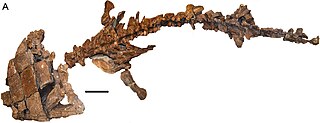
Siderops is an extinct genus of chigutisaurid temnospondyl from Early Jurassic of Australia, containing the species S. kehli.

Brachyopoidea is a superfamily of temnospondyls that lived during the Mesozoic. It contains the families Brachyopidae and Chigutisauridae. The earliest records of brachyopids are from the Lower Triassic in Australia. The latest-surviving member of the superfamily is the chigutisaurid Koolasuchus from the Early Cretaceous of Australia.

Lydekkerinidae is a family of stereospondyl temnospondyls that lived in the Early Triassic period. During this time period, lydekkerinids were widely distributed, with putative remains reported from Russia, Greenland, India, South Africa, Madagascar, Australia, and Antarctica. In contrast to most other stereospondyls, lydekkerinids were relatively small-bodied. The type genus is Lydekkerina, the namesake of the family and the best-known lydekkerinid.
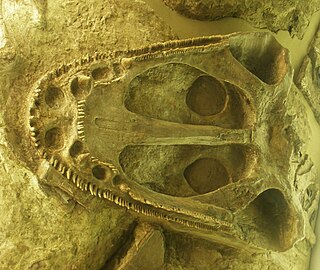
Mastodonsauridae is a family of capitosauroid temnospondyls. Fossils belonging to this family have been found in North America, Greenland, Europe, Asia, and Australia. The family Capitosauridae is synonymous with Mastodonsauridae.

Limnarchia is a clade of temnospondyls. It includes the mostly Carboniferous-Permian age Dvinosauria and the mostly Permian-Triassic age Stereospondylomorpha. The clade was named in a 2000 phylogenetic analysis of stereospondyls and their relatives. Limnarchia means "lake rulers" in Greek, in reference to their aquatic lifestyles and long existence over a span of approximately 200 million years from the Late Carboniferous to the Early Cretaceous. In phylogenetic terms, Limnarchia is a stem-based taxon including all temnospondyls more closely related to Parotosuchus than to Eryops. It is the sister group of the clade Euskelia, which is all temnospondyls more closely related to Eryops than to Parotosuchus. Limnarchians represent an evolutionary radiation of temnospondyls into aquatic environments, while euskelians represent a radiation into terrestrial environments. While many euskelians were adapted to life on land with strong limbs and bony scutes, most limnarchians were better adapted for the water with poorly developed limbs and lateral line sensory systems in their skulls.

Lydekkerina is an extinct genus of stereospondyl temnospondyl. It is the type genus of the family Lydekkerinidae. Fossils have been collected from Early Triassic deposits in South Africa and Australia. The type species is L. huxleyi, first described in 1889. While most other stereospondyls were semiaquatic, Lydekkerina was exclusively terrestrial.

Keratobrachyops is an extinct genus of trematosaurian temnospondyl found in the Arcadia Formation of Queensland, Australia. It had been thought to be a basal chigutisaurid but is now thought to be a basal brachyopomorph closely related to the genus Bothriceps, and may even be a synonym of it.
Kourerpeton is an extinct genus of dvinosaurian temnospondyl. Fossils of Kourerpeton were discovered in a window of a barber's shop in either Bisbee or Mesa, Arizona. Kourerpeton was named in 1976, with the type and only species being K. bradyi. It was originally assigned to the monotypic family Kourerpetidae, which has been alternatively spelled Kourerpetontidae.
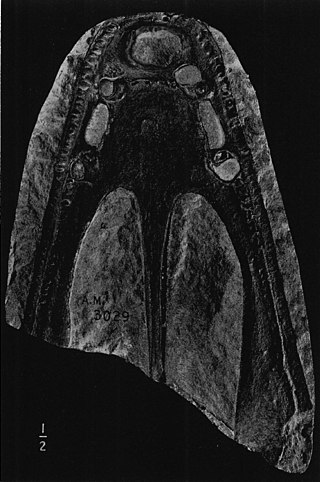
Stanocephalosaurus is an extinct genus of large-sized temnospondyls living through the early to mid Triassic. The etymology of its name most likely came from its long narrow skull when compared to other temnospondyls. Stanocephalosaurus lived an aquatic lifestyle, with some species even living in salt lakes. There are currently three recognized species and another that needs further material to establish its legitimacy. The three known species are Stanocephalosaurus pronus from the Middle Triassic in Tanzania, Stanocephalosaurus amenasensis from the Lower Triassic in Algeria, and Stanocephalosaurus birdi, from the middle Triassic in Arizona. Stanocephalosaurus rajareddyi from the Middle Triassic in central India needs further evidence in order to establish its relationship among other Stanocephalosaurs. Like other temnospondyls, Stanocephalosaurus was an aquatic carnivore. Evidence of multiple species discovered in a wide range of localities proves that Stanocephalosaurus were present all across Pangea throughout the early to mid Triassic.

Reptiles arose about 320 million years ago during the Carboniferous period. Reptiles, in the traditional sense of the term, are defined as animals that have scales or scutes, lay land-based hard-shelled eggs, and possess ectothermic metabolisms. So defined, the group is paraphyletic, excluding endothermic animals like birds that are descended from early traditionally-defined reptiles. A definition in accordance with phylogenetic nomenclature, which rejects paraphyletic groups, includes birds while excluding mammals and their synapsid ancestors. So defined, Reptilia is identical to Sauropsida.

Vigilius is an extinct genus of brachyopid temnospondyl amphibian from the Triassic of Arizona. It is known from the single type species Vigilius wellesi.

Galleonosaurus is a genus of basal ornithopod dinosaur from the Wonthaggi Formation of the Gippsland region of Victoria, Australia. The type and only species is Galleonosaurus dorisae.

Arenaerpeton is an extinct genus of chigutisaurid temnospondyl found in the Terrigal Formation of New South Wales, Australia. The type species is A. supinatus. The genus name is derived from the Latin "Arena", meaning "sand" ; and "erpeton" meaning thing that creeps. The species name "supinatus" means "supine", referring to the fact that the fossil is lying on its back.
























